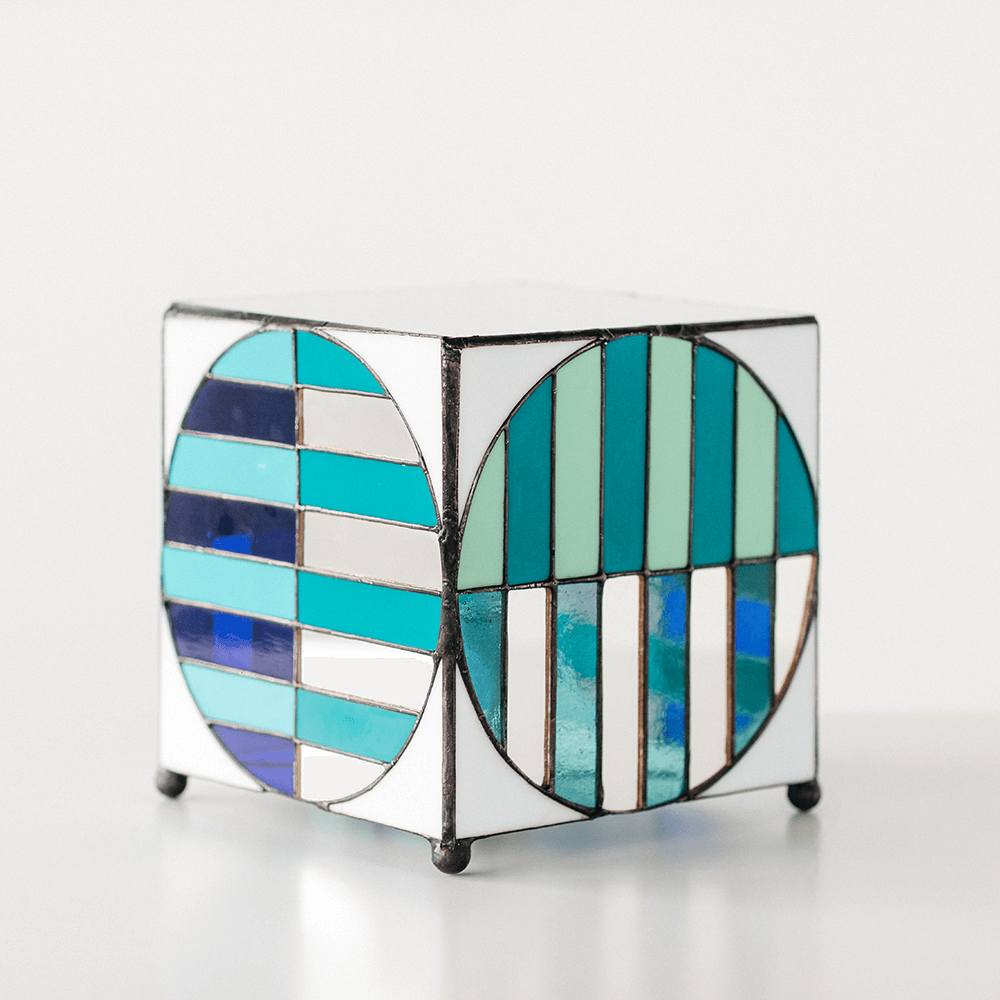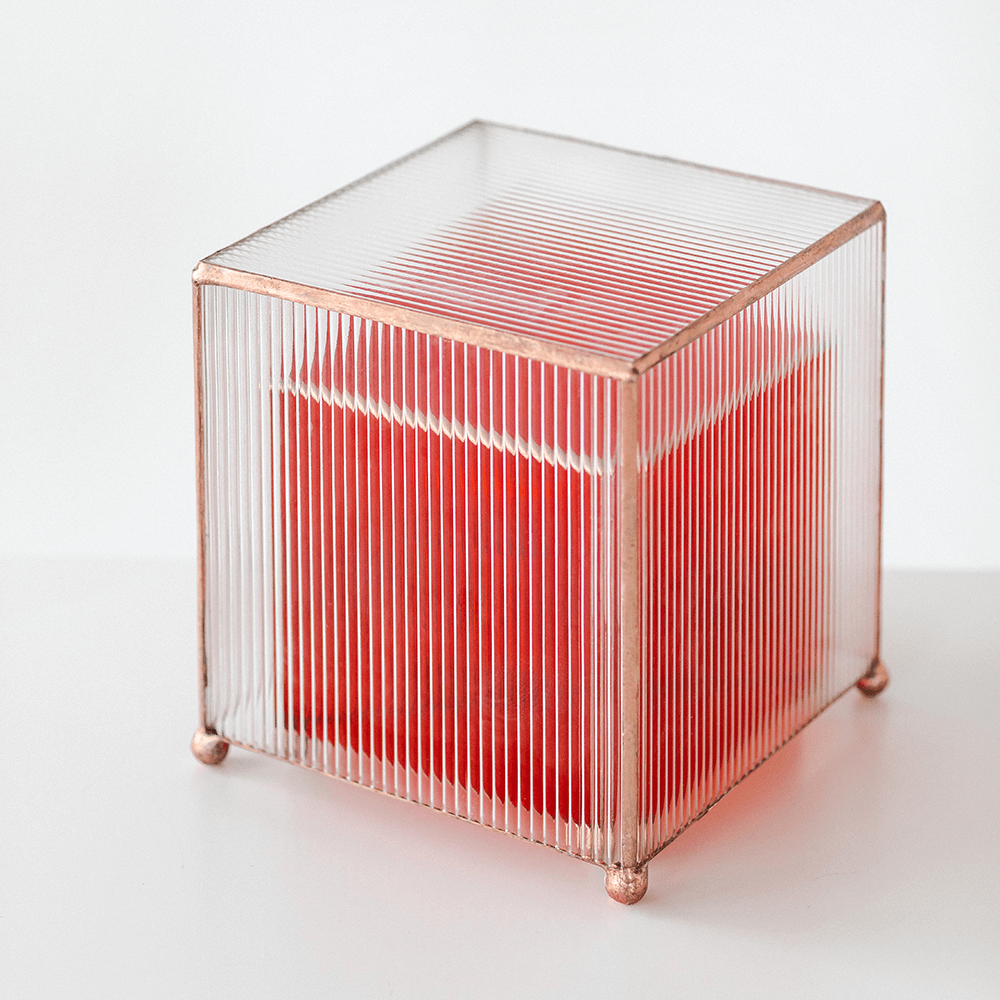The hazards of working in stained glass are easily mitigated with good studio practice. You must be vigilant, though, as you’ll work with fragile glass with sharp edges, lead and other chemicals, a motorized grinder, and a hot soldering iron. In over twenty years of working in glass I’ve needed stitches only once, and that was because my studio was a disorganized mess, with bins of glass stored improperly. I learned my lesson, and now continually strive for a tidy studio.
You do not need a huge space, but if at all possible find a dedicated spot so you won’t have to keep setting up and breaking down. Find an area away from food preparation or consumption, and away from your pets and kids. Good ventilation such as an exhaust fan or nearby window is a must. The workspace will get slightly messy, with glass chips and melted solder droplets on the floor, so cover a carpet or a fine wood floor with fireproof protection, such as a linoleum sheet. Keep your floor space clear of trip hazards.
STUDIO ESSENTIALS
- Good lighting. Multiple light sources spaced apart will prevent shadows as you lean over your work.
- Electrical outlets for the grinder and soldering iron.
- Sturdy and level table or workbench and chair at a comfortable height.
- Glass storage: a rack where larger sheets of glass can be stored vertically is useful. You’ll also want some bins for glass scrap: one for scrap to toss, and maybe a few for different shades of scrap to keep. Put all glass safely away when you move from step to step throughout the process.
- Chemical storage in closed containers away from kids and pets. Be especially careful with patina storage.
- Shelves for other tools, and maybe some airtight bins for foil.
SAFETY ESSENTIALS
- Fire extinguisher.
- Good ventilation, and a fume extractor or personal respiratory protition.
- Rubber gloves.
- Eye protection
- A broom and a dustpan for frequent floor and workbench sweep-ups.
- A soap specifically designed for lead removal.
- First aid kit, adhesive bandages, burn cream, antiseptic wipes, antibacterial gel/cream and an emergency plan.
GLASS HANDLING SAFETY
- Always hold sheets of glass vertically, especially larger full sheets. Never hold them horizontally like a platter. If there is an unseen fracture in the glass, the weight of holding it flat can cause it to break and possibly fall onto your body.
- If holding a piece of glass up to the light to see how it illuminates, never hold it up above your head, but position it away from your body, so that no body parts are beneath the glass in case it breaks or drops.
- Never run your hands along a glass edge.
- Wear sturdy closed-toe shoes and long pants.
- Always wear eye protection when cutting and grinding glass. Little chips can go flying, sometimes right toward your eyes, and to do stained glass you’re going to need those eyes!
- When grinding, you will create glass dust that would be extremely dangerous to inhale. To capture this dust, your grinder uses water to create and collect a slurry that should look like paste. Keep your grinder reservoir full of water, and be sure that the bit is wet. You never want to produce dry dust or powder.
SOLDERING SAFETY
Soldering presents a set of safety challenges: you are working with intense heat, liquid flux, and molten solder. Be aware that solder contains lead, which is poisonous and can enter the body by inhalation, ingestion, or through injured skin. Adhering to common sense precautions will protect you from these hazards.
- Always wear eye protection when soldering. Also wear long, sturdy pants and closed footwear. Hot flux may spatter, and molten solder forms scorching little balls that by nature roll off your workbench, possibly toward your legs or feet below.
- Wear disposable rubber gloves when soldering. When you’re working with glass, you’re bound to get some nicks from little glass splinters, and you don’t want to handle lead products with injured skin. Gloves will also save your skin from the chemicals in flux that hurt like mad if they get into a cut. Even when using gloves, take care to wash your hands thoroughly after soldering. A pumice soap or a lead removal soap will scrub off any harmful residue. Pretend you are an Emergency Room doctor getting ready for surgery, and scrub with vigor all the way up to your elbows.
- Flux creates fumes during soldering, and precautions must be taken to avoid inhaling them. A well-ventilated space is a must; ideally your studio will have a hood and exhaust, but an open window and fan can work. Additionally, you can use a fume extractor (such as a small personal one like the Hakko). Personal respirator masks offer additional protection – a ‘combination’ respirator will protect against both dust particles and fumes.
- If pregnant or breastfeeding, you should consult with your doctor to make an informed choice about working with these materials.
ADDITIONAL PRECAUTIONS
- Never eat, drink, or smoke in the glass studio.
- Shower and wash your hair after a soldering session.
- Use coveralls or work-only clothing in the studio, or at least change clothes after working.
- Use studio shoes that you remove at the threshold to avoid tracking bits of glass or solder into the rest of your home.
- While beyond the scope of this book, working with old lead came windows can present a high risk of lead poisoning. Over time, lead can oxidize, creating a powdery substance that can be easily inhaled. If you intend to expand your stained glass practice to repair and conservation, please research and take additional precautions.


